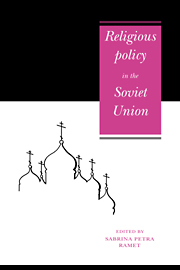Book contents
- Frontmatter
- Contents
- Notes on contributors
- Preface
- Part I Introduction
- Part II Policy apparatus
- Part III Education, socialisation, and values
- 6 Fear no evil: schools and religion in Soviet Russia, 1917–1941
- 7 Soviet schools, atheism and religion
- 8 The Ten Commandments as values in Soviet people's consciousness
- 9 Out of the kitchen, out of the temple: religion, atheism and women in the Soviet Union
- Part IV Cults and sects
- Part V The world of Christianity
- APPENDIX: Religious groups numbering 2,000 or more, in the USSR
- Index
9 - Out of the kitchen, out of the temple: religion, atheism and women in the Soviet Union
Published online by Cambridge University Press: 03 December 2009
- Frontmatter
- Contents
- Notes on contributors
- Preface
- Part I Introduction
- Part II Policy apparatus
- Part III Education, socialisation, and values
- 6 Fear no evil: schools and religion in Soviet Russia, 1917–1941
- 7 Soviet schools, atheism and religion
- 8 The Ten Commandments as values in Soviet people's consciousness
- 9 Out of the kitchen, out of the temple: religion, atheism and women in the Soviet Union
- Part IV Cults and sects
- Part V The world of Christianity
- APPENDIX: Religious groups numbering 2,000 or more, in the USSR
- Index
Summary
For many years it was a commonplace of atheist writings in the USSR that women made up the majority of religious believers. Indeed, it was not simply women, but ‘backward’ women of ‘low political consciousness’ – the elderly, the single, the poorly educated, and those somehow isolated from the ‘production process’. While this was a phenomenon said to be common throughout the industrialised world, its character was in some ways more pronounced in the Soviet Union which, despite being a socialist country – and thus by definition more progressive in its treatment of women than the capitalist world – had only recently taken the path of modern development. Moreover, Soviet women had been severely traumatised by their experience of war, revolution, and – unstated – terror, and were thus particularly susceptible to the consolation offered by religion.
In those parts of the old Russian Empire which had traditionally confessed Islam, the ‘problem’ of female religiosity was even more acute. Though women in Central Asia and other parts of the USSR were rarely allowed into the mosque or to play a prominent part in religious ceremonies, it was nonetheless religion that appeared to keep them in a subordinate position within society. Moreover, because they generally accepted this role and because they often took an important, and indeed primary, role in the education of very young children, women served as the main channel for the reproduction of ‘religious prejudices’.
Central to this analysis was the suggestion that female religiosity was part of a wider problem, rooted in unjust social structures which used religion to keep the people obedient and submissive.
- Type
- Chapter
- Information
- Religious Policy in the Soviet Union , pp. 206 - 228Publisher: Cambridge University PressPrint publication year: 1992

